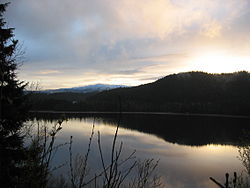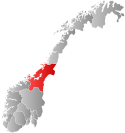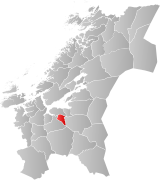Klæbu_Municipality
Klæbu
Former municipality in Trøndelag, Norway
Klæbu is a former municipality in Trøndelag county, Norway. It existed from 1838 until its dissolution in 2020 when it was incorporated into the neighboring Trondheim Municipality. It was located in the southern part of the Trondheim Region, about 20 kilometres (12 mi) south of the city of Trondheim. The administrative center was the village of Klæbu. The other major village in Klæbu municipality was Tanem.
This article may require copy editing for grammar, style, cohesion, tone, or spelling. (April 2024) |
Klæbu Municipality
Klæbu kommune | |
|---|---|
 | |
|
| |
 Trøndelag within Norway | |
 Klæbu within Trøndelag | |
| Coordinates: 63°16′34″N 10°30′51″E | |
| Country | Norway |
| County | Trøndelag |
| District | Trondheim Region |
| Established | 1 Jan 1838 |
| • Created as | Formannskapsdistrikt |
| Disestablished | 1 Jan 2020 |
| • Succeeded by | Trondheim Municipality |
| Administrative centre | Klæbu |
| Government | |
| • Mayor (2015-2019) | Kirsti Tømmervold (Ap) |
| Area (upon dissolution) | |
| • Total | 186.36 km2 (71.95 sq mi) |
| • Land | 175.06 km2 (67.59 sq mi) |
| • Water | 11.30 km2 (4.36 sq mi) 6.1% |
| • Rank | #337 in Norway |
| Population (2018) | |
| • Total | 6,094 |
| • Rank | #171 in Norway |
| • Density | 34.8/km2 (90/sq mi) |
| • Change (10 years) | |
| Demonym | Klæbygg[1] |
| Official language | |
| • Norwegian form | Bokmål |
| Time zone | UTC+01:00 (CET) |
| • Summer (DST) | UTC+02:00 (CEST) |
| ISO 3166 code | NO-5030[3] |
| Website | Official website |
Even though agriculture has traditionally been the main industry for Klæbu, the municipality most recently functioned more as a commuter town of Trondheim, where many of Klæbu's inhabitants work or attend school.
At the time of its dissolution in 2020, the 186-square-kilometre (72 sq mi) municipality was the 337th largest by area out of the 422 municipalities in Norway. Klæbu was the 171st most populous municipality in Norway with a population of 6,094. The municipality's population density was 34.8 inhabitants per square kilometre (90/sq mi) and its population had increased by 9.6% since 2010.[4][5]

The municipality of Klæbu was established on 1 January 1838 (see formannskapsdistrikt). On 1 January 1899, the small northwestern part of Klæbu (population: 533) was separated from Klæbu to form the new municipality of Tiller.[6]
On 1 January 2018, the municipality switched from the old Sør-Trøndelag county to the new Trøndelag county.
On 1 January 2020, the municipality of Klæbu merged with the municipality of Trondheim to the north.[7][8]
Name
The municipality (originally the parish) is named after the old Klæbu farm (Old Norse: Kleppabú) since the first Klæbu Church was built there. The first element is the plural genitive case of kleppr which means "rocky hill". The last element is bú which means "rural district". The district/parish has a lot of small rocky hills.[9]
Coat of arms
The coat of arms was granted on 8 July 1983 and it was in use until 1 January 2020 when the municipality was dissolved. The official blazon is "Argent, flaunches azure" (Norwegian: I sølv to buede blå flanker). This means the arms have a field (background) that has a tincture of argent which means it is commonly colored white, but if it is made out of metal, then silver is used. Each side of the arms have blue flaunches. The arms symbolize the Trangfossen waterfall in the Nidelva river, which is now the deepest canyon in Norway measuring 56 metres (184 ft). The river has been of great importance for the local development, for agriculture and hydroelectricity generation, hence the use of the waterfall as a typical symbol for the municipality. The waterfall is no longer visible as that part of the river became part of Bjørsjøen lake after the building of the dam at Hyttfossen. The arms were designed by Einar H. Skjervold.[10][11][12]
Churches
The Church of Norway had one parish (sokn) within the municipality of Klæbu. It is part of the Heimdal prosti (deanery) in the Diocese of Nidaros.
| Parish (sokn) | Church name | Location of the church | Year built |
|---|---|---|---|
| Klæbu | Klæbu Church | Klæbu | 1790 |
| Vassfjell Chapel | Vassfjellet mountain | 1974 |
The Nidelva river, which runs through the area of Klæbu, is a large source of hydroelectric power with a total of 3 power stations within the municipality borders. The river runs north from the lake Selbusjøen. The mountain Vassfjellet is located along the western border with Melhus.
The landlocked municipality of Klæbu has three municipalities that border it: Melhus is located to the west and south, Selbu is located to the east, and Trondheim is to the north.
The newspaper KlæbuPosten is published in Klæbu.[13]
All municipalities in Norway, including Klæbu, are responsible for primary education (through 10th grade), outpatient health services, senior citizen services, unemployment and other social services, zoning, economic development, and municipal roads. The municipality is governed by a municipal council of elected representatives, which in turn elect a mayor.[14] The municipality falls under the Trøndelag District Court and the Frostating Court of Appeal.
Municipal council
The municipal council (Kommunestyre) of Klæbu is made up of 23 representatives that are elected to four year terms. The party breakdown of the final municipal council was as follows:
| Party name (in Norwegian) | Number of representatives | |
|---|---|---|
| Labour Party (Arbeiderpartiet) | 9 | |
| Progress Party (Fremskrittspartiet) | 2 | |
| Green Party (Miljøpartiet De Grønne) | 1 | |
| Conservative Party (Høyre) | 3 | |
| Centre Party (Senterpartiet) | 3 | |
| Socialist Left Party (Sosialistisk Venstreparti) | 2 | |
| Liberal Party (Venstre) | 3 | |
| Total number of members: | 23 | |
| Party name (in Norwegian) | Number of representatives | |
|---|---|---|
| Labour Party (Arbeiderpartiet) | 8 | |
| Progress Party (Fremskrittspartiet) | 3 | |
| Conservative Party (Høyre) | 5 | |
| Centre Party (Senterpartiet) | 3 | |
| Socialist Left Party (Sosialistisk Venstreparti) | 2 | |
| Liberal Party (Venstre) | 2 | |
| Total number of members: | 23 | |
| Party name (in Norwegian) | Number of representatives | |
|---|---|---|
| Labour Party (Arbeiderpartiet) | 6 | |
| Progress Party (Fremskrittspartiet) | 5 | |
| Conservative Party (Høyre) | 3 | |
| Christian Democratic Party (Kristelig Folkeparti) | 1 | |
| Centre Party (Senterpartiet) | 3 | |
| Socialist Left Party (Sosialistisk Venstreparti) | 3 | |
| Liberal Party (Venstre) | 2 | |
| Total number of members: | 23 | |
| Party name (in Norwegian) | Number of representatives | |
|---|---|---|
| Labour Party (Arbeiderpartiet) | 5 | |
| Progress Party (Fremskrittspartiet) | 4 | |
| Conservative Party (Høyre) | 3 | |
| Christian Democratic Party (Kristelig Folkeparti) | 2 | |
| Centre Party (Senterpartiet) | 1 | |
| Socialist Left Party (Sosialistisk Venstreparti) | 8 | |
| Total number of members: | 23 | |
| Party name (in Norwegian) | Number of representatives | |
|---|---|---|
| Labour Party (Arbeiderpartiet) | 6 | |
| Progress Party (Fremskrittspartiet) | 2 | |
| Conservative Party (Høyre) | 4 | |
| Christian Democratic Party (Kristelig Folkeparti) | 2 | |
| Centre Party (Senterpartiet) | 2 | |
| Socialist Left Party (Sosialistisk Venstreparti) | 6 | |
| Liberal Party (Venstre) | 1 | |
| Total number of members: | 23 | |
| Party name (in Norwegian) | Number of representatives | |
|---|---|---|
| Labour Party (Arbeiderpartiet) | 7 | |
| Progress Party (Fremskrittspartiet) | 1 | |
| Conservative Party (Høyre) | 5 | |
| Christian Democratic Party (Kristelig Folkeparti) | 1 | |
| Centre Party (Senterpartiet) | 2 | |
| Socialist Left Party (Sosialistisk Venstreparti) | 6 | |
| Liberal Party (Venstre) | 1 | |
| Total number of members: | 23 | |
| Party name (in Norwegian) | Number of representatives | |
|---|---|---|
| Labour Party (Arbeiderpartiet) | 10 | |
| Progress Party (Fremskrittspartiet) | 1 | |
| Conservative Party (Høyre) | 5 | |
| Christian Democratic Party (Kristelig Folkeparti) | 1 | |
| Centre Party (Senterpartiet) | 3 | |
| Socialist Left Party (Sosialistisk Venstreparti) | 4 | |
| Liberal Party (Venstre) | 1 | |
| Total number of members: | 25 | |
| Party name (in Norwegian) | Number of representatives | |
|---|---|---|
| Labour Party (Arbeiderpartiet) | 11 | |
| Progress Party (Fremskrittspartiet) | 2 | |
| Conservative Party (Høyre) | 5 | |
| Christian Democratic Party (Kristelig Folkeparti) | 1 | |
| Centre Party (Senterpartiet) | 2 | |
| Socialist Left Party (Sosialistisk Venstreparti) | 2 | |
| Liberal Party (Venstre) | 2 | |
| Total number of members: | 25 | |
| Party name (in Norwegian) | Number of representatives | |
|---|---|---|
| Labour Party (Arbeiderpartiet) | 11 | |
| Progress Party (Fremskrittspartiet) | 1 | |
| Conservative Party (Høyre) | 6 | |
| Socialist Left Party (Sosialistisk Venstreparti) | 2 | |
| Liberal Party (Venstre) | 1 | |
| Joint list of the Centre Party (Senterpartiet) and the Christian Democratic Party (Kristelig Folkeparti) | 4 | |
| Total number of members: | 25 | |
| Party name (in Norwegian) | Number of representatives | |
|---|---|---|
| Labour Party (Arbeiderpartiet) | 7 | |
| Conservative Party (Høyre) | 5 | |
| Christian Democratic Party (Kristelig Folkeparti) | 1 | |
| Centre Party (Senterpartiet) | 2 | |
| Socialist Left Party (Sosialistisk Venstreparti) | 1 | |
| Liberal Party (Venstre) | 1 | |
| Total number of members: | 17 | |
| Party name (in Norwegian) | Number of representatives | |
|---|---|---|
| Labour Party (Arbeiderpartiet) | 7 | |
| Socialist Left Party (Sosialistisk Venstreparti) | 1 | |
| Joint list of the Conservative Party (Høyre), Christian Democratic Party (Kristelig Folkeparti), New People's Party (Nye Folkepartiet), Centre Party (Senterpartiet), and Liberal Party (Venstre) | 8 | |
| The Free Voters (De Frie Velgere) | 1 | |
| Total number of members: | 17 | |
| Party name (in Norwegian) | Number of representatives | |
|---|---|---|
| Labour Party (Arbeiderpartiet) | 9 | |
| Christian Democratic Party (Kristelig Folkeparti) | 1 | |
| Joint List(s) of Non-Socialist Parties (Borgerlige Felleslister) | 7 | |
| Total number of members: | 17 | |
| Party name (in Norwegian) | Number of representatives | |
|---|---|---|
| Labour Party (Arbeiderpartiet) | 7 | |
| Joint List(s) of Non-Socialist Parties (Borgerlige Felleslister) | 6 | |
| Total number of members: | 13 | |
| Party name (in Norwegian) | Number of representatives | |
|---|---|---|
| Labour Party (Arbeiderpartiet) | 8 | |
| Centre Party (Senterpartiet) | 2 | |
| Joint List(s) of Non-Socialist Parties (Borgerlige Felleslister) | 3 | |
| Total number of members: | 13 | |
| Party name (in Norwegian) | Number of representatives | |
|---|---|---|
| Labour Party (Arbeiderpartiet) | 8 | |
| Conservative Party (Høyre) | 1 | |
| Christian Democratic Party (Kristelig Folkeparti) | 1 | |
| Centre Party (Senterpartiet) | 2 | |
| Liberal Party (Venstre) | 1 | |
| Total number of members: | 13 | |
| Party name (in Norwegian) | Number of representatives | |
|---|---|---|
| Labour Party (Arbeiderpartiet) | 7 | |
| Joint List(s) of Non-Socialist Parties (Borgerlige Felleslister) | 6 | |
| Total number of members: | 13 | |
| Party name (in Norwegian) | Number of representatives | |
|---|---|---|
| Labour Party (Arbeiderpartiet) | 6 | |
| Joint List(s) of Non-Socialist Parties (Borgerlige Felleslister) | 6 | |
| Total number of members: | 12 | |
| Party name (in Norwegian) | Number of representatives | |
|---|---|---|
| Labour Party (Arbeiderpartiet) | 6 | |
| Liberal Party (Venstre) | 2 | |
| Joint List(s) of Non-Socialist Parties (Borgerlige Felleslister) | 4 | |
| Total number of members: | 12 | |
| Party name (in Norwegian) | Number of representatives | |
|---|---|---|
| Labour Party (Arbeiderpartiet) | 6 | |
| Joint List(s) of Non-Socialist Parties (Borgerlige Felleslister) | 6 | |
| Total number of members: | 12 | |
| Party name (in Norwegian) | Number of representatives | |
|---|---|---|
| Labour Party (Arbeiderpartiet) | 7 | |
| Joint List(s) of Non-Socialist Parties (Borgerlige Felleslister) | 5 | |
| Total number of members: | 12 | |
| Note: Due to the German occupation of Norway during World War II, no elections were held for new municipal councils until after the war ended in 1945. | ||
Mayors
The mayors of Klæbu:[32]
- 1838–1839: Hans Jørgen Darre
- 1840–1851: Lars Larsen Forseth, Sr.
- 1852–1855: Eskild Lysklæth
- 1856–1863: Nicolai Ulstad
- 1864–1867: Eskild Lysklæth
- 1868–1879: Lars Larsen Forseth, Jr. (V)
- 1880–1881: Sivert Thonstad (H)
- 1882–1887: Ludvig Lysklæth
- 1888–1892: Hannibal Hartmann
- 1892–1893: Andreas Nideng (H)
- 1894–1895: Sivert Thonstad (H)
- 1896–1904: Ole Aune (V)
- 1905–1913: Paul O. Lium (V)
- 1914–1916: Karl Ulstad (V)
- 1917–1919: Ole Halseth (Ap)
- 1920–1928: Paul O. Lium (Bp)
- 1929–1931: Ole Halseth (Ap)
- 1932–1934: John E. Nervik (Ap)
- 1935–1937: Bernt Forset (Bp)
- 1938–1941: John E. Nervik (Ap)
- 1941–1945: Torbjørn Lium (NS)
- 1945-1945: Bernt Forset (Bp)
- 1945-1945: John E. Nervik (Ap)
- 1946–1957: Johan Nervik (Ap)
- 1958–1959: Lars Bendiksvoll (Ap)
- 1960–1963: Sigurd Gjølgali (Ap)
- 1964–1967: Lars Bendiksvoll (Ap)
- 1968–1979: Reidar Fosshode (Ap)
- 1980–1983: Arild Huitfeldt (H)
- 1984–1987: Ivar Myhre (Ap)
- 1988–1989: Kai Nordseth (Ap)
- 1990–1991: Sverre Tangen (Ap)
- 1992–2007: Ivar Skei (SV)
- 2007–2015: Jarle Martin Gundersen (Sp)
- 2015–2019: Kirsti Tømmervold (Ap)
- "Navn på steder og personer: Innbyggjarnamn" (in Norwegian). Språkrådet.
- "Forskrift om målvedtak i kommunar og fylkeskommunar" (in Norwegian). Lovdata.no.
- Bolstad, Erik; Thorsnæs, Geir, eds. (2023-01-26). "Kommunenummer". Store norske leksikon (in Norwegian). Kunnskapsforlaget.
- Statistisk sentralbyrå (2018). "Table: 06913: Population 1 January and population changes during the calendar year (M)" (in Norwegian). Retrieved 2019-03-23.
- Statistisk sentralbyrå. "09280: Area of land and fresh water (km²) (M)" (in Norwegian). Retrieved 2019-03-23.
- Jukvam, Dag (1999). "Historisk oversikt over endringer i kommune- og fylkesinndelingen" (PDF) (in Norwegian). Statistisk sentralbyrå.
- Trondheim Kommune (17 June 2016). "Ja til sammenslåing av Klæbu og Trondheim". Archived from the original on 8 October 2017. Retrieved 17 June 2016.
- "Bakgrunn - kommunesammenslåing" (in Norwegian). Trondheim kommune. Retrieved 2018-03-12.
- Rygh, Oluf (1901). Norske gaardnavne: Søndre Trondhjems amt (in Norwegian) (14 ed.). Kristiania, Norge: W. C. Fabritius & sønners bogtrikkeri. p. 364.
- "Civic heraldry of Norway - Norske Kommunevåpen". Heraldry of the World. Retrieved 2023-02-12.
- "Klæbu, South Trøndelag (Norway)". Flags of the World. Retrieved 2023-02-12.
- "Godkjenning av våpen og flagg". Lovdata.no (in Norwegian). Norges kommunal- og arbeidsdepartementet. 1983-09-11. Retrieved 2023-02-12.
- Hansen, Tore, ed. (2016-05-12). "kommunestyre". Store norske leksikon (in Norwegian). Kunnskapsforlaget. Retrieved 2019-01-01.
- "Table: 04813: Members of the local councils, by party/electoral list at the Municipal Council election (M)" (in Norwegian). Statistics Norway.
- "Tall for Norge: Kommunestyrevalg 2011 - Sør-Trøndelag". Valg Direktoratet. Retrieved 2019-10-19.
- "Kommunestyrevalget 1995" (PDF) (in Norwegian). Oslo-Kongsvinger: Statistisk sentralbyrå. 1996. Retrieved 2020-04-14.
- "Kommunestyrevalget 1991" (PDF) (in Norwegian). Oslo-Kongsvinger: Statistisk sentralbyrå. 1993. Retrieved 2020-04-14.
- "Kommunestyrevalget 1987" (PDF) (in Norwegian). Oslo-Kongsvinger: Statistisk sentralbyrå. 1988. Retrieved 2020-04-14.
- "Kommunestyrevalget 1983" (PDF) (in Norwegian). Oslo-Kongsvinger: Statistisk sentralbyrå. 1984. Retrieved 2020-04-14.
- "Kommunestyrevalget 1979" (PDF) (in Norwegian). Oslo: Statistisk sentralbyrå. 1979. Retrieved 2020-04-14.
- "Kommunevalgene 1975" (PDF) (in Norwegian). Oslo: Statistisk sentralbyrå. 1977. Retrieved 2020-04-14.
- "Kommunevalgene 1972" (PDF) (in Norwegian). Oslo: Statistisk sentralbyrå. 1973. Retrieved 2020-04-14.
- "Kommunevalgene 1967" (PDF) (in Norwegian). Oslo: Statistisk sentralbyrå. 1967. Retrieved 2020-04-14.
- "Kommunevalgene 1963" (PDF) (in Norwegian). Oslo: Statistisk sentralbyrå. 1964. Retrieved 2020-04-14.
- "Kommunevalgene og Ordførervalgene 1959" (PDF) (in Norwegian). Oslo: Statistisk sentralbyrå. 1960. Retrieved 2020-04-14.
- "Kommunevalgene og Ordførervalgene 1955" (PDF) (in Norwegian). Oslo: Statistisk sentralbyrå. 1957. Retrieved 2020-04-14.
- "Kommunevalgene og Ordførervalgene 1951" (PDF) (in Norwegian). Oslo: Statistisk sentralbyrå. 1952. Retrieved 2020-04-14.
- "Kommunevalgene og Ordførervalgene 1947" (PDF) (in Norwegian). Oslo: Statistisk sentralbyrå. 1948. Retrieved 2020-04-14.
- "Kommunevalgene og Ordførervalgene 1945" (PDF) (in Norwegian). Oslo: Statistisk sentralbyrå. 1947. Retrieved 2020-04-14.
- "Kommunevalgene og Ordførervalgene 1937" (PDF) (in Norwegian). Oslo: Statistisk sentralbyrå. 1938. Retrieved 2020-04-14.
- Hals, Harald, ed. (1987). Festskrift. Kommunalt selvstyre i Sør-Trøndelag 150 år 1837–1987 (in Norwegian). Trondheim. ISBN 9788290551198.
{{cite book}}: CS1 maint: location missing publisher (link)
 Trøndelag travel guide from Wikivoyage
Trøndelag travel guide from Wikivoyage- Municipal fact sheet from Statistics Norway (in Norwegian)
- Klæbu church (in Norwegian)

